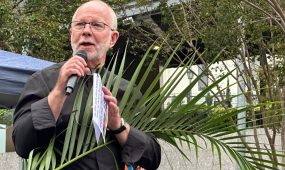Is beauty in the (he)art of the beholder?
Reflections
“What really interests me is that, given our notions of beauty might be different from person to person or culture to culture, the presence of God can be found in all kinds of situations, places, people, artworks, and music,” says Jonathan Sargeant from St Francis College

How do you know a person or a thing is beautiful? What sense do humans have that enables them to detect beauty in front of them?
You awaken in your tent after a rainy night and stroll out to the headland to see the waves crashing majestically over weather-beaten rocks, mist rising with the golden sun. God is there.
You look to the people you love, noticing the line of their jaw and the history in their faces, whether three or 33 or 75 years old. God is there.
You wander around a gallery and suddenly find yourself frozen, transfixed by one work. You stare, drinking in the thoughtful, emotional connection the artist has made with you. God is there.
In each scenario our minds (and hearts) are doing something, discerning something. But is it an instinct, a gut reaction? Is it a process? Is it a mystical thing beyond comprehension? Or are there criteria hard-wired into humans that make this happen?
Humans have wondered about these questions for a long time. Once we start joining in on this wondering we’re delving into the field of aesthetics. You might have heard someone describe a thing as “aesthetically pleasing”. You know what this means – the thing looks good! But what are aesthetics?
German philosopher Immanuel Kant called aesthetics, “the science which treats the conditions of sensuous perception”. If an anaesthetic is something that dulls the perceptions, then you can use the term “aesthetic” to describe anything that does the opposite – it stimulates or enlivens the senses. Back in 1750, Kant’s contemporary, Alexander Baumgarten called aesthetics “the art of thinking beautifully” and even “the art of forming taste”.
If the use of the word “taste” raises questions for you, you’re probably not alone. When we invoke taste in the discussion, does it mean there are things that are objectively beautiful, from which there can be no disagreement? Are there, for instance, pieces of music that just are beautiful? Music is a good example to use here. Some might sit in the Cathedral hearing a particular choral setting and think, “This is undoubtedly beautiful.” But the person next to them in the pews might be wishing they were at a jazz club hearing discordant saxophones over elastic bass and skittering drums, because that is where true beauty lives for them.
Others have tried to list principles of beauty, hoping to ward off subjectivity. Eighteenth century artist and writer William Hogarth suggested six of these. According to Hogarth, to be ascribed as beautiful, there must be:
- fitness of the parts to some design
- variety in as many ways as possible
- uniformity, regularity or symmetry, which is only beautiful when it helps to preserve the character of fitness
- simplicity or distinctness, which give pleasure not in itself, but through its enabling the eye to enjoy variety with ease
- intricacy, which provides employment for our active energies, leading the eye on “a wanton kind of chase”
- quantity or magnitude, which draws our attention and produces admiration and awe.
It’s easy to look at that list and nod in agreement. There’s some thinking that human faces look beautiful when they are symmetrical – something we detect subconsciously. Yet when you take people’s pictures and flip one side to make them truly symmetrical, most note how odd the result is. Is that because we are just used to seeing people as they are, rarely truly symmetrical or because Hogarth is wrong?
Advertisement
Complicating our exploration are the clear examples we can draw about how notions of beauty change. Once powdered wigs and ruffles were considered the height of western beauty. Once the pale double-chinned Rubens models of the 17th century were the apex of beauty. In the 1980s, athletic bronzed super-models provided the standard few could reach. Once the genteel slim stature of Fred Astaire set the pace. Now the muscled figure of Chris Hemsworth lights up our screens more regularly.
Yes, certainly the body shapes people think of as beautiful have changed radically, for both males and females. We can argue here that this is the case especially for females. Film theorist Laura Mulvey has conceptualised something called “The Male Gaze”, which refers to the frequent framing of objects of visual art so that the viewer is situated in a “masculine” position of appreciation. That definition is from contemporary feminist aestheticist Carolyn Korsmeyer. Hence we see statistically that films are more likely to contain scenes of women in states of undress than men. The key idea is that ideas of beauty can be seen to be culturally influenced and transmitted by the products of culture: films, TV, and visual art of all forms. There’s much more to say about this, but we’ll leave this for another time.
One thing is for sure – no matter what our conceptions of beauty might be, no matter how different they might be from person to person or culture to culture, the idea that God is often detected in our appreciation of beauty is altogether uncontroversial. When I suggested the three opening scenarios – involving the beach, loved ones and visual art – and noted God’s presence could be discerned, you probably didn’t give that a second thought. At least, it seems obvious to those of us who identify with faith.
Advertisement
That there is overlap between aesthetics and religious experience is a time-honoured idea and seems true to us when we sense God’s presence while appreciating the beauty of a view, a painting or a piece of music.
What really interests me is that, given our notions of beauty might be different from person to person or culture to culture, the presence of God can be found in all kinds of situations, places, people, artworks, and music. For one it is in the symphonies of Bach, for another in the industrial soundscapes and metal scrapings of Japanese aural sculptor Merzbow. Along with much of scripture and our own experience that points to the wonders inherent in the appreciation of God’s created diversity, this exploration lands us with that thought as well. As 13th-14th century German theologian Meister Eckhart said:
“God is infinite in (God’s) simplicity and simple in (God’s) infinity. Therefore, (God) is everywhere and is everywhere complete. God is in the innermost part of each and every thing.”
Where there is beauty, God is there. And there is beauty everywhere if we have the eyes to see it.
Jonathan Sargeant is the Director of Lay Education at St Francis College where he also lectures in several Practical Theology subjects. Coming up next semester is ‘THL256 Theology and the Arts’ where ideas of aesthetics in the arts are deeply explored. You can find out more about ‘THL256 Theology and the Arts’ on the St Francis College website.
Editor’s note: If you found this feature interesting and you would like to know more about studying theology at St Francis College, come to the St Francis College Open Day and find out about the wide range of study options. Visit the St Francis College website to register or for more information. The Open Day will be held on Saturday 4 June between 10 am and 12 noon.






